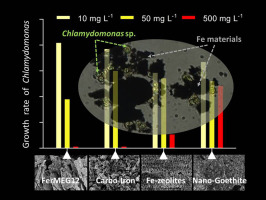Ecotoxicology and Environmental Safety ( IF 6.2 ) Pub Date : 2018-02-22 , DOI: 10.1016/j.ecoenv.2018.02.027 Nhung H.A. Nguyen , Nadia R. Von Moos , Vera I. Slaveykova , Katrin Mackenzie , Rainer U. Meckenstock , Silke Thűmmler , Julian Bosch , Alena Ševců

|
As nanoremediation strategies for in-situ groundwater treatment extend beyond nanoiron-based applications to adsorption and oxidation, ecotoxicological evaluations of newly developed materials are required. The biological effects of four new materials with different iron (Fe) speciations ([i] FerMEG12 - pristine flake-like milled Fe(0) nanoparticles (nZVI), [ii] Carbo-Iron® - Fe(0)-nanoclusters containing activated carbon (AC) composite, [iii] Trap-Ox® Fe-BEA35 (Fe-zeolite) - Fe-doped zeolite, and [iv] Nano-Goethite - ‘pure’ FeOOH) were studied using the unicellular green alga Chlamydomonas sp. as a model test system. Algal growth rate, chlorophyll fluorescence, efficiency of photosystem II, membrane integrity and reactive oxygen species (ROS) generation were assessed following exposure to 10, 50 and 500 mg L−1 of the particles for 2 h and 24 h. The particles had a concentration-, material- and time-dependent effect on Chlamydomonas sp., with increased algal growth rate after 24 h. Conversely, significant intracellular ROS levels were detected after 2 h, with much lower levels after 24 h. All Fe-nanomaterials displayed similar Z-average sizes and zeta-potentials at 2 h and 24 h. Effects on Chlamydomonas sp. decreased in the order FerMEG12 > Carbo-Iron® > Fe-zeolite > Nano-Goethite. Ecotoxicological studies were challenged due to some particle properties, i.e. dark colour, effect of constituents and a tendency to agglomerate, especially at high concentrations. All particles exhibited potential to induce significant toxicity at high concentrations (500 mg L−1), though such concentrations would rapidly decrease to mg or µg L−1 in aquatic environments, levels harmless to Chlamydomonas sp. The presented findings contribute to the practical usage of particle-based nanoremediation in environmental restoration.
中文翻译:

四种含铁纳米修复材料对绿藻衣藻的生物学效应。
由于用于原位地下水处理的纳米修复策略已从基于纳米铁的应用扩展到吸附和氧化,因此需要对新开发的材料进行生态毒理学评估。的四个新的材料具有不同的铁的生物效应(Fe)的赋存([I] FerMEG12 -原始片状铣削的Fe(0)纳米颗粒(的nZVI),[II]的碳氮化铁® -的Fe(0)-nanoclusters含有活性碳(AC)复合材料,[iii]Trap-Ox®Fe-BEA35(铁沸石)-掺杂铁的沸石和[iv]纳米针铁矿-“纯” FeOOH)使用单细胞绿藻衣藻进行了研究。sp。作为模型测试系统。在暴露于10、50和500 mg L -1的颗粒2 h和24 h后,评估了藻类生长速率,叶绿素荧光,光系统II的效率,膜完整性和活性氧(ROS)的产生。颗粒对衣藻具有浓度,物质和时间依赖性,在24小时后藻类生长速率增加。相反,在2小时后检测到明显的细胞内ROS水平,而在24小时后则显着降低。所有的铁纳米材料在2 h和24 h时都显示出相似的Z平均尺寸和Zeta电位。对衣藻的影响sp。依次降低> FerMEG12>Carbo-Iron®>铁沸石>纳米针铁矿。生态毒理学研究受到挑战,这是由于某些颗粒特性,即深色,成分的作用和附聚的趋势,特别是在高浓度下。在高浓度(500 mg L -1)下,所有颗粒均具有潜在的引起明显毒性的潜力,尽管在水生环境中,此类浓度会迅速降低至mg或µg L -1,对衣藻的危害无害。提出的发现有助于在环境恢复中基于颗粒的纳米修复的实际应用。











































 京公网安备 11010802027423号
京公网安备 11010802027423号